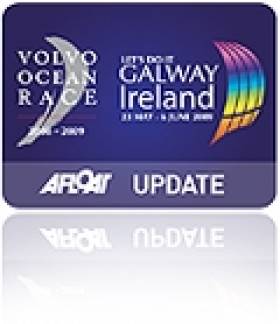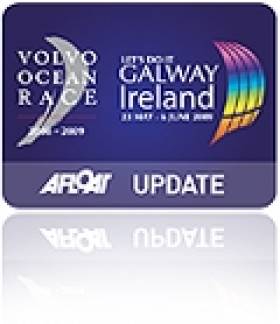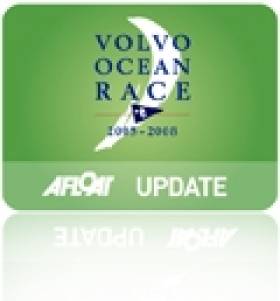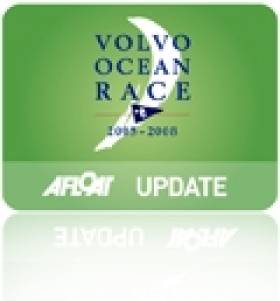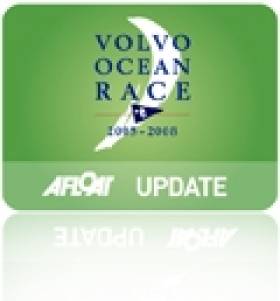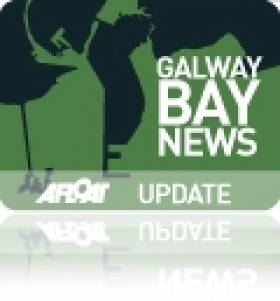Displaying items by tag: Volvo Ocean Race
Free Mobile App for Visitors to Volvo Ocean Race Galway
#VOLVO OCEAN RACE - Silicon Republic reports that researchers at NUI Galway have created a free mobile app for visitors to the city during the Volvo Ocean Race festivities starting this weekend.
Graduate students at the university's Digital Enterprise Research Institute (DERI) developed the app to provide visitors with up-to-date details of the festival programme from 30 June to 8 July - such as the slipway locations and dock gate opening times - as well as handy hints and tips for making the most of the City of the Tribes.
The DERI team have also integrated some of their own social technologies into the app such as 'Connect and Chat' and 'Tweet Cliques' so users can connect with their friends in the city.
The Volvo Ocean Race Festival Galway app is available from Apple's App Store and from the Google Play store for Android devices.
Silicon Republic has more on the story HERE.
#VOR – Catch all the latest action and news from the Volvo Ocean Race on TG4 . TG4 will broadcast the in-port race live from Lorient next Saturday as well as the start of Leg 9 on Sunday. On Saturday 7th July, TG4 will broadcast the in-port Race from Galway. The race started in Alicante, Spain last October and finishes in Galway in July. The 2011-12 race is the 11th edition of the event with six boats participating: Groupama Sailing Team, Team Telefónica, PUMA Ocean Racing by BERG, CAMPER with Emirates Team NZ, Abu Dhabi Ocean Racing and Team Sanya.
*UPDATE: Please note change of timings to in-port race in Lorient on Saturday and start of Leg 9 on Sunday next*
Coverage on TG4
SATURDAY 30 JUNE
11:45am LIVE Volvo Ocean Race
Live coverage of the In-Port Race from Lorient, France. Situated in Brittany in north-west France, Lorient has a long-standing link to the maritime world and is the first French harbour to welcome the Race since La Rochelle did in 2002. The race course for the in-port race is always close to shore, so spectators will have a great view of the races.
SUNDAY 1 JULY
11:45am LIVE Volvo Ocean Race
Live coverage of the start of Leg 9, which sees the boats depart Lorient and make their way to Galway - a distance of 485 nautical miles (898 kilometres). Ironically, Lorient has been a twin town of Galway since 1978. The last stage of the Volvo Ocean Race will be short but intense with around 3 days at sea. The gun will be fired at 1pm in the Lorient's bay and the boat will head back south to Belle-Ile before they head back up towards Galway. The race's final sprint from France to Ireland takes the fleet on a predominantly coastal course: first north along the shores of western Brittany, then across the English Channel and up the prehistoric south coast of Ireland to the finish line in Galway. Short as it is compared to the preceding legs, this final passage is fraught with obstacles to be negotiated including commercial shipping lanes and rocky outcrops, as well as a seemingly endless series of headlands and major tidal gates. Added to this is the potential for rapidly changing weather conditions, which will keep the crews on their toes as they battle their way to the finish line in Galway.
MONDAY 2 JULY
7:30pm Volvo Ocean Race
Highlights from the start of Leg 9, which sees the boats depart Lorient and make their way to Galway, a distance of 485 nautical miles (898 kilometres).
SATURDAY 7 JULY
12:45pm LIVE Volvo Ocean Race
Live coverage of the in-port race from Galway Bay. After nine months, nine legs and 39,000 nautical miles it all comes down to this one race in Galway that will be broadcast live on TG4. The In-Port Race is the final scoring opportunity for teams in the 2011-2012 edition of the race so this is where the overall podium positions could be awarded. The fleet will sail for an intense hour around a course positioned close to land to both challenge the crew and delight those lining the shore along Salthill and Barna. The Galway stopover for the 2008-09 Volvo Ocean Race was a huge success for the city and for the race, and once again the Volvo Ocean Race will visit this ancient west coast city of Ireland, this time as the finish line of the 2011-12 race. The Volvo Ocean Race fleet will finish the race in the fabled waters of Galway Bay in July 2012 where they are bound to receive a tremendous Irish welcome at the end of the final leg from Lorient.
9:40pm Volvo Ocean Race
Highlights from the in-port race in Galway and the Prize Giving.
SUNDAY 29 JULY
2:00pm Volvo Ocean Race Official Film
A look back at the 2011/2012 race as the boats left Alicante last October, sailing around the world and visiting ports and cities such as Cape Town, Abu Dhabi, Sanya, Auckland, Itajaí, Miami, Lisbon, Lorient and Galway. It is undeniably the world's premier global race and one of the most demanding team sporting events in the world. The race is the ultimate mix of world class sporting competition and on the edge adventure, a unique blend of onshore glamour with offshore drama and endurance.
#VOLVO OCEAN RACE - A Fine Gael senator last week called on the people of Galway to raise €100,000 for arts and culture events during the Volvo Ocean Race finale, The Irish Times reports.
Senator Fidelma Healy-Eames said the funding raised by event organisers Let's Do It Galway would be matched with €20,000 from the State by Arts Minister Jimmy Deenihan under a "philanthropy leverage initiative".
Private sponsorship has so far been slow off the mark for the week-long festivities surrounding the race conclusion, with the cost of events – including the biggest free open-air music festival of the year - expected to reach a total of €7 million.
Disabled Sailors More Than Welcome at Galway VOR Finale
#VOLVO OCEAN RACE - A new accessible pontoon and ramp in Galway Harbour will enable disabled sailors to get fully involved in events to celebrate the Volvo Ocean Race finale next weekend, the Galway City Tribune reports.
The permanent pontoon has been set up at the docks in the city centre, giving wheelchair users complete access to and from boats moored in the marina - along with the thousands who will be given the opportunity to learn to sail during the VOR weekend.
A highlight of the festivities will be the Irish Disabled Sailing Association regatta, which will see over 100 sailors with physical disabilities in competition on Galway Bay.
Previously the only access for disabled sailors in Galway was via a small slipway at Galway Bay Sailing Club in Oranmore, which made boarding and alighting an awkward process.
But the new pontoon is hoped to leave a lasting legacy for the City of the Tribes - and encourage many more wheelchair users to get afloat.
“The rehearsal last week went really well," said Liz Gantly of the Galway Speeders Club, which promotes sport for young people with disabilities. "We are hoping to have over 100 disabled people from all over the country trying out sailing during the Volvo Ocean Race.”
The Galway City Tribune has more on the story HERE.
#VOR – Craft on the water in the Galway bay area may be inspected by the Garda Water Unit according to a marine notice issued tonight by Galway Harbour Company setting out how pleasure craft are to behave during the Volvo Ocean Race finale from June 30th.
Galway Harbour Master Brian Sheridan who issued the notice says the 'safety of all while afloat during the Volvo Ocean Race Stopover at Galway is of prime importance'.
The notice also prohibits the use of tenders or dinghies to get ashore from a swinging mooring instead a Water Taxi service should be used.
In accordance with the Maritime Safety Act 2005, the Garda Water Unit will be paying particular attention to lifejacket use, vessel seaworthiness, vessel insurance and alcohol abuse.
The Irish Coast Guard will continue to monitor the following VHF Channels on Galway Bay: Ch 16, 67, 04 & Digital Selective Calling DSC70.
The full notice is available for download below as a pdf document.
#VOR – Galway Harbour Master Brian Sheridan has issued a marine notice about a temporary pedestrian walkway to be placed over the River Corrib as part of the preparations for Galway's finale of the Volvo Ocean Race 2012.
The pedestrian walkway will be fixed at the Fishmarket Square and at the Canal Basin.
Works commenced on Saturday 16th June and are expected to be completed on 29th June 2012.
The pedestrian walkways will be removed after the event, commencing the week of July 9th 2012. See attached drawing.
Mariners are advised to proceed with extreme caution when navigating in the vicinity of the mouth of the river and are not permitted to navigate upstream of the Canal Basin lock gate. See Exclusion Zone on drawing and the full notice attached here as word document download.
Multihulls Head for Galway Bay Championships
#vor – 40 catamarans will be raced by two handed teams in front of the promenade in Salthill, Galway on Saturday, June 30th and Sunday July 1st as they compete in the Irish Multihull Association (IMA) National regatta sponsored by local taxi company Pro-Cabs.
Only once every 5 years is this competition hosted in the West of Ireland and for 2012, in association with the Volvo Ocean Race Grand Finale Festival, Galway Bay Sailing Club is the genial host.
The catamaran, a multihulled sailing craft - typically two hulls linked together by a taught trampoline, has its roots in cultures and traditions as old as the early Polynesian settlers who used them to reach far-flung islands.
Today these cats have evolved to become specialist speed machines on the water, ranging from the popular "everyday" 16 and 18 foot length boats to the 45 and future 72 foot competitors of the Americas Cup. Trading under names like Wildcat, Tiger, Hurricane and Tornado, you can just imagine all that these sensational boats can do. Flying their colourful, billowing spinnakers (balloon-like sail) off 30 foot high masts, they are sleek and graceful, most manoeuvrable and lend the ability to be sailed close to the edge at terrific speeds.
The edge being that point before everything can come tumbling down in a spectacular capsize. Of all the various cat types sailing on June 30th, the largest fleet will be the Dart 16s. All locally owned boats, they are famed for their yellow hulls and while not as fast, they are much more robust and can take on stronger winds than their delicate fibreglass constructed 18 foot cousins.
Right now, besides the 40 or so local cat sailors, there are another 40 all over the country, from Cork to Antrim, and even as far as England, fine tuning their skills and rigs to put on a display not seen so close to the shore in Galway before.
Expect to see the 25 knot thrills and maybe even some spectacular spills of catamaran racing up-close. The first of four races blasts off at 12.00 on Saturday, starting with 3 windward-leewards, The Cardpoint, The Coffey Construction and The Nevins Pharmacy, finishing with The Coach House Coastal. Sunday features The Avon Ri Hobie Centre and The Bow Waves windward-leeward races followed by The McSwiggans Coastal.
If you like what you see from Salthill promenade Sat 30th – Sun 1st and you think you might like to try it out, then contact GBSC (www.gbsc.ie / 091-794527) or your own local sailing club for more information, or contact the IMA (www.multihull.ie / [email protected] ) who will try to put you in touch with the nearest club to you.
Fair or formidable weather, these cats and their sailors will put on a fast and colourful display of skill and speed at the Pro-Cabs IMA Nationals 2012 on the wet and wonderful Galway Bay!
Irish Olympic Sailor Turned Race Officer Set for Galway's Photo Finish in the Volvo Ocean Race
#vor – By the time the fleet of six boats reaches Galway at the start of July, they will have travelled 39,000 nautical miles, the equivalent of travelling from Ireland to Australia four times, yet it looks like the race could be decided on a 60 minute inshore race just metres from the shore. And the man responsible for making sure the race runs smoothly is former Northern Ireland Olympian Bill O'Hara from Ballyholme in County Down.
The Volvo Ocean Race is a round-the-world yacht race that started in Alicante last October and has called in ports such as Abu Dhabi, Cape Town, Itajai in Brazil, Sanya in China, Auckland, Miami and a nail biting finish is set for Galway in a matter of weeks. Eleven crew on board each boat battle the elements in state-of-the art 70ft racing yachts capable of remarkable speeds.
Bill O'Hara is a two-time Irish sailing Olympian who learnt to sail in Ballyholme. In total Bill has been involved in six Olympics in various capacities including coach and judge. Bill was also the Principle Race Officer (PRO) for the last Volvo Ocean Race, the role he currently holds. Considering the race is the largest, most high profile offshore yacht race in the world, Bill described it as an honour to even be considered for such a role.
When asked what the role entailed, Bill said: "At first glance it may seem simple, organising a few inshore races and a few offshore races for six boats, all with fully professional crews. When you then start to consider each race has in the region of 2,000 spectator boats on the water, numerous helicopters, multi million pound boats that will be racing mere meters from the shores of some of the most impressive cities of the world to some of the most remote places on earth, all at speeds of over 40mph it starts to get a bit more difficult."
Bill himself admits his early years in sailing were more for fun and they weren't taken too seriously until the Laser European Championships came to his home club in 1979. It was at this point that Bill started to take sailing seriously and has had a remarkable sailing record and career ever since.
Bill added: "I am very fortunate to have been involved with such prestigious events around the world but this edition of the Volvo Ocean Race is shaping up to be the most exciting. For what started off to be an event dominated by Team Telefonica there are now four teams in the running for the top spot. The way it's looking I think the race could be decided during the inshore race in Galway which will be one of the most exciting sailing races ever seen, all within meters of the Galway shoreline.
"The Volvo Ocean Race has changed how the world views sailing. Spectators and fans are being brought closer and closer to the action all the time. Media crew members capture the action on board, helicopters capture the inshore action and live tracking allows for 24-hour monitoring meaning fans can feel part of the action 24/7, no matter where they or the boats are. Another incredibly popular innovation is the 'Virtual Race', which gives fans the chance to take part in all the legs via an impressive online game with over 160,000 people taking part."
The action doesn't just take place on the water - each stopover is a festival in itself and the Galway finish is set to be spectacular. During the nine day period from 30th June – 8th July there will be over 260 events including concerts from international bands, gigs from comedians such as Dara O'Briain, fashion shows, business expo's on innovation, sustainability, marine, and numerous on-the-water activities such as try sailing and kite surfing demonstrations.
Speaking about what Galway has to offer visitors, Bill said: "I can assure any visitors they will not be disappointed, almost all events are free of charge, the entire city is getting involved and for those who want to watch the action there will be giant screens and ample space along the scenic Galway coastline. The competitors and teams who took part in the last race agreed that the hospitality and reception in Galway was the most memorable. In 2009 well over 600,000 people visited the city and as this year is the final stop, and also as the race is so closely matched the atmosphere is going to be electric over the nine days."
The Galway stopover runs from the 30th June – 8th July. The boats will be racing on Thursday, Friday and Saturday all within close range of the shore. Almost all of the 260 events are free of charge.
#VESSEL VOLVO VILLAGE – As previously reported the ocean going heavy-lift container cargoship Deo Volente (2007/2,999grt) which is carrying the spectacular Volvo Ocean Race 'pop-up' spectator village from Lisbon is en-route off the Clare coast and is due to dock in Galway Docks this afternoon, writes Jehan Ashmore.
The high-tech village which is assembled from 70 crates and is one of two such villages which have accompanied the race across the globe is in the holds of the 105m long Dutch owned vessel. When Deo Volente enters through the dock she is to berth at Dún Aengus Dock North.
According to Capt. Brian Sheridan, Harbourmaster of the Galway Harbour Company, the containership is the first the port has ever had to handle and the unloading is part of "the unfolding jigsaw that is the Volvo Ocean Race".
The unloading process will create huge excitement as the village emerges from its containers and transforms the dockside into a gigantic sports and entertainment arena.
Deo Volente is operated by Hartman Seatrade, which they classify as a mini heavy-lift vessel. She is capable of carrying vessels as deck-cargo, unusual sized cargo as well as 236 TEU containers. On board are two 120 mt (metric tonnes) cranes, built by Liebherr which are mounted on the starboard side. Using both cranes the loading gear can handle a maximum tandem total weight of 240 mt.
The appearance of such a vessel will no doubt bring back memories to many Galwegians when in 2011 there was the saga of attempting to load two former Aran Islands fast-ferry sisters bound for new owners in Mauritius.
Albeit on this occasion of the impending Volvo Ocean Race, the process of unloading the pop-up village is far more conventional in the form of containers, though what is required is the 60 specialist construction workers involved in the task of assembling the village. The vessel is to stay in port overnight and scheduled to depart tomorrow afternoon.
As for last year's protracted loading of the fast-ferries, it was heavy-lift ship Thor Gitta (4,078grt) that stepped in after another similar vessel, Pantanal (7,837grt) ran aground in Rossaveal on 31 March. It was from the joint fishing and ferry port, where the ferries were originally due to be loaded.
Instead the ferries had to transfer to Galway Harbour where the vessel eventually departed nearly a month later on the 8,300 mile delivery voyage to the Indian Ocean.
#VOR – Thousands will be given an opportunity to learn to sail during the spectacular finale of the Volvo Ocean Race on Galway Bay next month say Galway organisers who have lined up 42 separate on-water events which will take place on Galway Bay during the course of the Volvo festival.
Details were announced at a briefing by Galway Bay Sailing Club and The Irish Sailing Association in the House Hotel last Friday night.
As part of a nine day seafaring festival built around the race finale sailing clubs want to get a record breaking number of people onto the water between June 30th and July 8th.
The arrival of the Volvo fleet will put the city at the centre of a global media spotlight, the briefing was told, but for many local sailors the highlight of the festival will be an opportunity to take part in one or other of the highly competitive sailing regattas on the Bay or to have a go on one of the high speed Volvo tri sailboats.
The events being organised by Galway Bay Sailing Club include the Irish Multihull National Championships which has attracted an entry of over 40 boats. These high speed craft will be seen off Salthill on Sat 30th June & Sun 1st July.
The club is also hosting GB12 cruiser racing series and 50 yachts are lining up for this three-day event, attracting boats from Westport, Limerick, Clifden, Sligo, Galway and the UK.
Galway is also taking a leading role in the dramatic round Rockall Race, which starts from the city on Sunday 24th, the same day as the Round Ireland race from Wicklow.
One of the biggest gathering of boats ever to happen will take place on Sunday 1st July at Galway docks and will be organised by GBSC member Pierce Purcell, who is expecting up to 200 boats to take part in the colourful parade of sail. Weather permitting, the fleet will meet at Salthill and join a junior parade of sail off Mutton Island.
Pierce wants all water users to join this parade of sail including yachts, sailing dinghies, traditional boats, power boats, ribs, fishing boats, scout groups windsurfers and canoes. A reviewing vessel will anchor off the channel to the docks and a band will welcome the armada into the marina to add to the shore festival just a day before the Volvo 70s arrive.
One of the highlights will be the Irish Disabled Sailing Association regatta. Over 100 sailors who have physical disabilities have already applied for the accessible sailing series.
This joint event is designed to encourage people with disablities to take to the water.
GBSC are also running a schools team-racing event. John Killeen, President of Let's Do it Global said he was delighted with the enthusiasm of the sailing clubs and of the 2,000 volunteers from all over Ireland who will assist in running the biggest sailing event of the year.
The Mayor of Galway Hildegarde Naughton said this 'event was huge for not only Galway, but all of Ireland' and would attract massive media coverage as well as visitors to Galway city.
Over twenty sailing clubs and training centres including power boating, windsurfing, scouting, the RNLI, the Harbour Company and Irish Water Safety were represented at the House Hotel in Galway at the weekend.




























